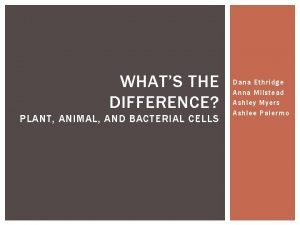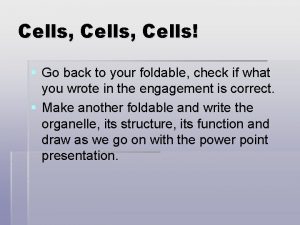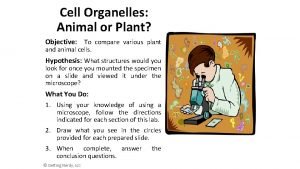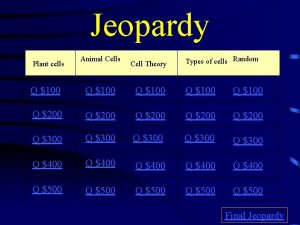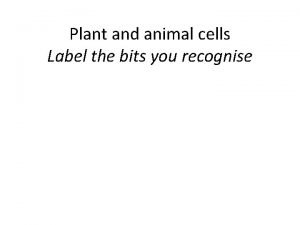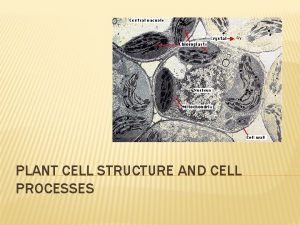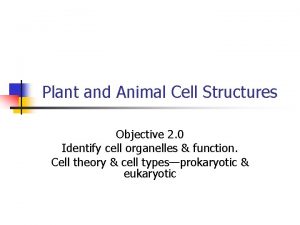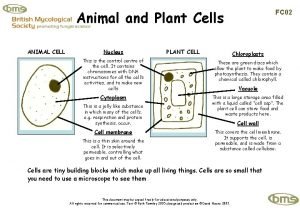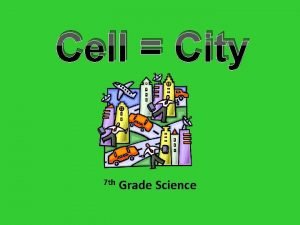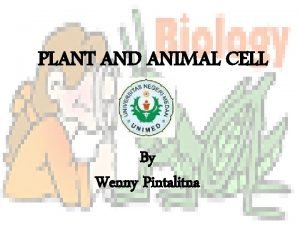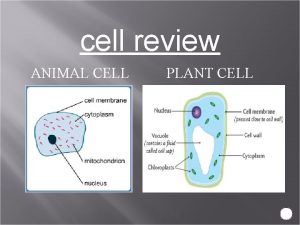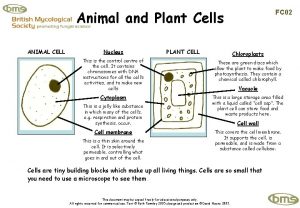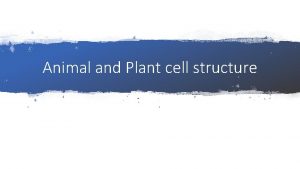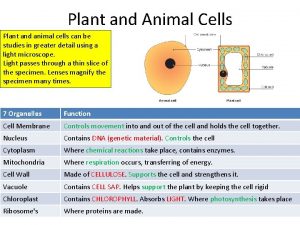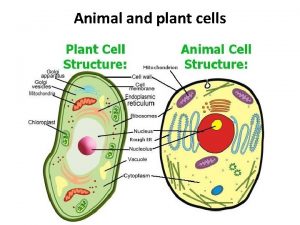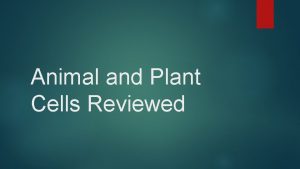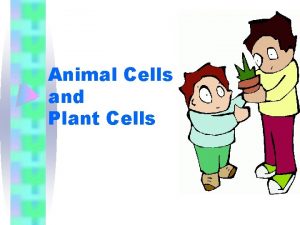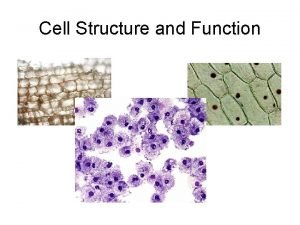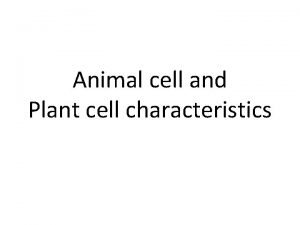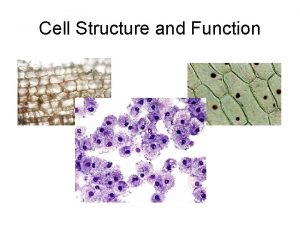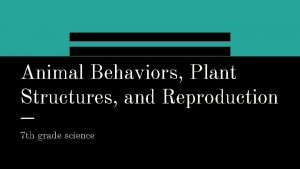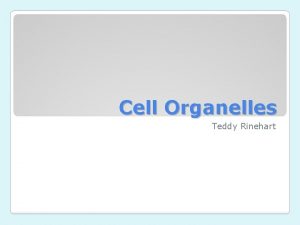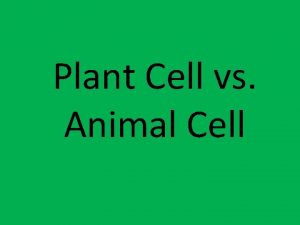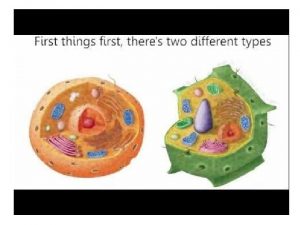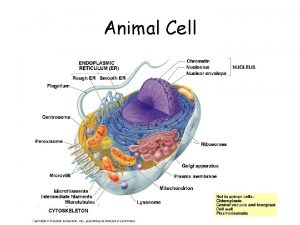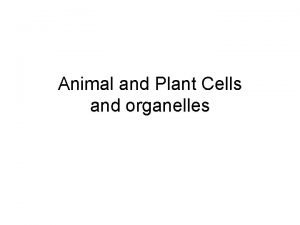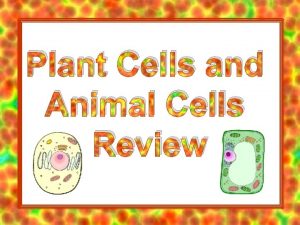The Plant and Animal Cell The specifics Cell



























- Slides: 27

The Plant and Animal Cell The specifics

Cell Types • Prokaryotic – Do NOT contain membrane organelles. These are the first types of cells to exist when life began. They are very simple and primitive. They can only carry out one life processes at a time. • Ex. Bacteria

• Eukaryotic – contain membrane -bound organelles, such as the nucleus. • These are more complex and able to carry out multiple life functions at once. • Ex. Plant and animal cells • Pro. vs. Euk.

Cell Size and Shape • Prokaryotic cells are smaller (as a general rule) and lack much of the internal compartmentalization (ER and Golgi) and complexity of eukaryotic cells. • No matter which type of cell we are considering, all cells have certain features in common: cell membrane, DNA, cytoplasm, and ribosomes.

Shape • The shapes of cells are quite varied with some, such as neurons, being longer than they are wide and others, like erythrocytes (red blood cells) being equidimensional. • Some cells are encased in a rigid wall, which constrains their shape, while others have a flexible cell membrane (and no rigid cell wall).

Size • The size of cells is also related to their functions. Eggs (ova) are very large, often being the largest cells an organism produces. • The large size of many eggs is related to the process of development that occurs after the egg is fertilized (a zygote). When the contents of the egg are used in a rapid series of cellular divisions, each requiring tremendous amounts of energy that is available in the ova.


Cell Organelles

Plant and Animal Organelles • • • • 1. Plasma (or cell) membrane 2. Cytoplasm 3. Nucleus 4. Nucleolus 5. Endoplasmic reticulum (ER) 6. Ribosomes 7. Mitochondria (singular, mitochondrion) 8. Golgi complex 9. Lysosomes 10. Vacuoles 11. Centrioles 12. Cell wall 13. Chloroplasts

Plasma (or cell) membrane • 1. Plasma (or cell) membrane: Thin, two-layered film that surrounds entire cell. • Consists of lipid molecules in which protein molecules are embedded. • It is described as semipermeable, or selectively permeable. This means it permits the passage or transport of certain materials into and out of the cell, and prevents transport of other materials.

Cytoplasm • 2. Cytoplasm: The fluid-like material inside the plasma membrane and outside the nucleus of the cell. Various organelles are present in the cytoplasm and many biochemical processes occur in it.

Nucleus • 3. Nucleus: Structure containing the chromosomes and DNA of the cell, which carry hereditary information and direct the biochemical activities of the cell. • Separated from the cytoplasm by the nuclear membrane.

Nucleolus • 4. Nucleolus: Structure within the nucleus that is involved in the synthesis of the r. RNA found in ribosomes. (this organelle makes part of a ribosome)

Endoplasmic reticulum (ER) • 5. Endoplasmic reticulum (ER): A network of channels in the cytoplasm that function in synthesizing, transporting, detoxifing, and storing substances made in the cell. • Two types: • Rough and Smooth

Picture of Endoplasmic Reticulm

Ribosomes: • 6. Ribosomes: Small structures that are the sites of protein synthesis. There are large numbers of ribosomes in the cell, which may be free in the cytoplasm or attached to the surface of the ER.

Mitochondria • 7. Mitochondria (singular, mitochondrion): Sites of aerobic cellular respiration. • Most ATP of the cell is made in the mitochondria. • Converts the bonds of organic molecules into ATP

Picture of Mitochondria

Golgi complex • 8. Golgi complex: Membrane-bound channels in which products from the cell are processed and packaged. • Finishes proteins to make enzymes – lysosomes

Picture of Golgi

Lysosomes • 9. Lysosomes: Structures that contain digestive enzymes and which take part in the digestion of food materials, old organelles, and foreign substances.

Vacuoles • 10. Vacuoles: Spaces in the cytoplasm enclosed by a membrane and containing water and other materials. • Many one-celled organisms have food vacuoles in which ingested food is stored and digested • contractile vacuoles that pump excess water out of the cell.

Centrioles • 11. Centrioles: A pair if cylindrical structures found just outside the nuclear membrane in most animal cells. The centrioles are active during cell division. • Make microtubules and microfilaments

Only found in PLANT Cells • Central Vacuole: contains water, and a place to store wastes that may be harmful to the cell.

Only found in PLANT Cells • 12. Cell wall: A nonliving structure composed mainly of cellulose, which surrounds the cell and gives it strength and rigidity; usually present in plant cells. It has pores or openings that permit free passage of water and dissolved substances.

Only found in PLANT Cells • 13. Chloroplasts: Structures, found in plant cells, algae, and some other protists, that contain the pigment chlorophyll and are the sites of photosynthesis.

Cilia and Flagella: Structure and Movement • Cilia and Flagella – propels cells through environment and move materials over cell surface.
 Plant cell outline
Plant cell outline Plant cell structure
Plant cell structure Plant cell vs animal cell
Plant cell vs animal cell Idealized plant cell
Idealized plant cell Plant vs animal cells venn diagram
Plant vs animal cells venn diagram Animal cell and plant cell
Animal cell and plant cell Whats the difference between animal and plant cells
Whats the difference between animal and plant cells Differences between plant animal and bacterial cells
Differences between plant animal and bacterial cells Plant and animal cell foldable
Plant and animal cell foldable Structure of animal cell under electron microscope
Structure of animal cell under electron microscope Plant animal cell
Plant animal cell Animal and plant cell jeopardy
Animal and plant cell jeopardy Label a plant and animal cell
Label a plant and animal cell Plant or animal cell
Plant or animal cell Which cell is larger plant or animal
Which cell is larger plant or animal Celula animal
Celula animal Animal or plant cell
Animal or plant cell What is the function of cell wall in plant cell
What is the function of cell wall in plant cell Cell city project animal cell
Cell city project animal cell Cell city analogy answer key
Cell city analogy answer key Eukaryotic cell animal cell
Eukaryotic cell animal cell Tronsmo plant pathology and plant diseases download
Tronsmo plant pathology and plant diseases download Tronsmo plant pathology and plant diseases download
Tronsmo plant pathology and plant diseases download Tronsmo plant pathology and plant diseases download
Tronsmo plant pathology and plant diseases download Venn diagram of plants and animals
Venn diagram of plants and animals Paragraph on animal cell
Paragraph on animal cell How animal cells use nutrients
How animal cells use nutrients Plant and animal cells
Plant and animal cells






